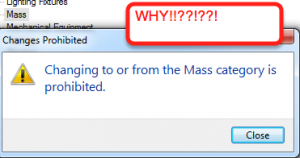Yes! I’m really going to start this back up. A post here, A post there. Maybe one in between. Either way, I’ll be trudging through this series as well as posting the occasional impromptu tutorial post. In the meantime, I’m going to just leave the text that I wrote over 9 months ago and just let it go from there. It’s actually quite short and is just another large step on the way to understanding families. Enjoy, comment and see you for the next one.
Well, I thought all this preliminary explanation that is leading up to family creation would bore everyone, but I’ve never had so many hits on my site! This is awesome! I thought I was going to make the next one a preemptive strike on modeling and get down and dirty with some geometry creation but seeing these stats kinda makes me think I should just chug along; those who are looking for geometry creation will be back in good time.
So here we are, the next session in our family creation series. Today we’re going to look at a couple of the templates that allow us to begin our families from and what exactly comes in a template.
[kml_flashembed movie=”http://cre8iveThings.com/jingPlayer/jingloader.swf” allowfullscreen=”true” fvars=”content=http://cre8iveThings.com/revit/video/TotD-120207-Families2.2.swf”/]
As we pointed out in the first video, this is where a lot of first time family creators kinda give Revit the ol’ o.O face, launch FF and type something like “Well, my first attempt in Revit Family Editor didn’t go so hot” into a Google search to see what comes up. I’ve witnessed the results of those who didn’t Google anything, it’s usually a Column that ends up in the Plumbing Fixtures Category (I’ve seen it!). So while I can’t show you every detail and facet of every template I can at least give you the guts of what is in a template so you know what to look for when you are choosing a template.
Most importantly, and hopefully obvious from the template names, the templates start you off in the appropriate category.
Category templates also set up some of your parameters for you, filling in some important information that you most likely would have forgotten to take care of.
Now some categories even have proprietary information that is specific to that family type in Revit. For instance Curtain Wall Panel templates give special references that Revit will read in order to allow that panel to fill a section of a Curtain Wall properly. These references are not given in a Door or Window template. More importantly, Curtain Wall Panels start off with only 3 categories that are specific to the Curtain Wall system in Revit… but Curtain Walls are a different topic all together.
Generic Families Categories allow you to assign a family to a particular category…
but not ANY category (why’d they even make that an option?!).
Simply put; there’s a lot of information that can be gathered just from knowing your templates. Which template belongs where. FYI, different templates come with different flavors. Structural has some templates that Arch and MEP doesn’t have and vis-a-vis. So take some time to learn what each template has to offer, start with one you’re particularly interested in (like the door template).
I also mentioned about what to look for if your family templates are not showing up. I will update this later (sorry, it’s late and I need sleep!).
Next time, we’ll talk about hosted templates and what they offer. Until then, I hope you enjoyed and I look forward to seeing you around for yet another, RevitTotD!
.Carl






One response to “Revit TotD – 2.7.2012 | Somewhere to Start Families 2.2”
[…] RST2011, MEP2011, RAC2011, AD2101 Added next post in the series to the ToC: Revit TotD – 2.7.2012 | Somewhere to Start Families 2.2 Review, comment, reply. […]